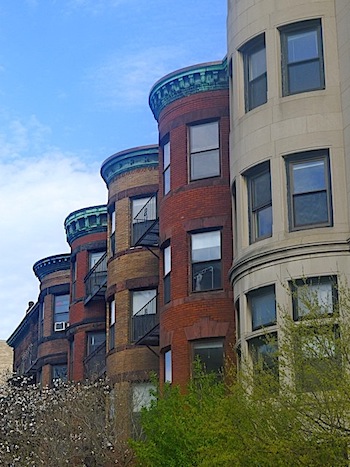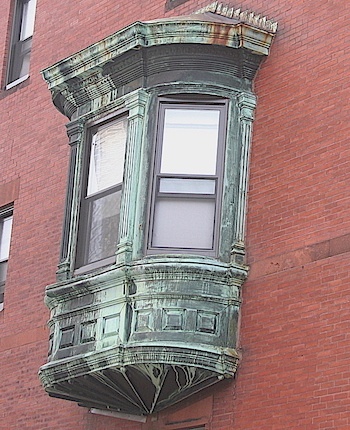Visual Arts Feature: A Walk in the City — Seeing Architectural Details and History in a Time of Covid-19
By Mark Favermann
Ironically, sheltering at home reminds us that walking through some neighborhoods in Boston is an aesthetically enriching experience.
Archway entrance to 857 Beacon Street. Photo: Mark Favermann
Walking has become an expression of personal freedom as we stay home/stay healthy and hunker down. In the Era of Coronavirus one of the few opportunities to be liberated from our shelter-in-place mandate is to go for a walk — as long as we wear a surgical mask and don’t go near anyone.
As each of us walks around Boston or in our own communities the experience is somewhat Rashomon-like: idiosyncratic personal perceptions predominate. There is no “correct” way to look at a city or town. The built environment delights and sometimes disappoints. To me, the traditional Boston urbanscape suffuses charm, presence, and calm. Older Boston reflects a European scale, offering welcoming streets that express an attitude — quiet, a bit understated, with a hint of former grandeur and even a wisp of mystery. For the most part, the city’s newer buildings come off as uninvited guests, alien interlopers.
Located off the westward corridor of Beacon Street, I live on a rather treeless, short dead-end street near the border of the City of Boston and the Town of Brookline. I am fortunate to live and work in an 1897 carriage house, a one-off in my small neighborhood. A carriage turntable can still be detected in my basement. The skylight in the back of the building was probably used for lowering hay for the horses.
My street is located in a section of the Fenway Neighborhood called Audubon Circle, and it has its own distinct identity. More on that later. Due west from Kenmore Square, venerable Fenway Park is located a couple blocks away. At Park Drive and Brookline Avenue sits a former Art Deco building, a Sears regional distribution center that became the Landmark Center and is now named 401 Park Drive, with its floors of offices and Time Out Food Hall.

Roofline Along Beacon Street between Miner and Aberdeen Streets. Photo: Mark Favermann
The structural character of the area could best be described as mid 19th-Century Renaissance Revival, sprinkled with late 19th- and early 20th-Century Classical Revivals. The structures were built between 1888 to around 1915; they were erected as an extension of the more fashionable Back Bay residential district.
Lined with substantial single-family row houses, three-family buildings, and larger apartment complexes, the area boasts several architecturally significant edifices, including Queen Anne/Romanesque row houses that typify the earliest stage of the neighborhood’s development, such as 918-924 Beacon Street (1889). Highly individual row-house designs appear in the Renaissance Revival building at 875 Beacon Street and the Georgian or Classical Revival building at 877 Beacon Street. Both houses were built in 1895. The six-storied Beaux Arts Inverness at 857 Beacon Street, built in the 1890s, was one of the first large multiunit area buildings.
The neighborhood’s focal point is Audubon Circle. Like so many of historic Boston’s elegantly landscaped locations, Audubon Circle was designed in 1887 by Frederick Law Olmsted Sr. According to the Boston Landmarks Commission, the area is defined as “a major crossroads distinguished by a central circle, 250 feet in diameter, at the intersection of Park Drive and Beacon Street.” As time passed, increasing traffic and political indifference decreed that the Circle be poorly modified by city engineers. Thankfully, in the last few years, administrators finally got around to organizing the Circle so it is no longer among the Commonwealth’s top three vehicular accident intersections.
With its high white steeple silhouetted against the sky, located on the eastern rim of Audubon Circle, sits a neighborhood landmark, the fine Ralph Adams Cram–designed Second Church in Boston (also known as the Ruggles Baptist Church). Built in 1914, it is a huge contrast to his other more Modern Gothic designs. A distinguished Boston-based architect, Cram (1863-1942) was also responsible for the design of many other churches and university campus structures around the country, including the Cathedral of Saint John the Divine in New York City, Ashmont’s All Saints’ Church, Rice University, and the University of Richmond. He was also the supervising architect of Princeton University.
Since 2006, up until mid-March, construction work in my neighborhood has been a constant. Not limited to just weekdays, this generated lots of inconvenience and disruption: blocked streets, limited parking in a limited parking area, the sound of jackhammers and constant beeping of trucks backing up, and too frequent power outages. In the last six weeks, the construction cacophony has vanished. It is regrettable that fighting a pandemic is the reason for the much-needed respite. The reasons for the upheaval—several undistinguished and rather soulless buildings as well as unnecessary and mostly unused bike routes (which take away from what was already limited parking)—have not been worth the pain and suffering of the residents.
The first thing you notice when taking a walk is how clean the air feels and looks — no pollution. Given the neighborhood’s various types of buildings and structures, the richness of the materials used and the wealth of sculptural architectural details, carefully looking at the environs turns walking into an aesthetically enriching experience. There is an abundance of marvelous visual details, which stimulates your curiosity about the urban history around you.
Medieval Townscape Parapet on top of 879 Beacon Street. Photo: Mark Favermann
Most blocks in the neighborhood proffer a pleasing line of rooftops, their compatible cornices beautifully framing the shapes and colors of various buildings. There are also memorable details distributed throughout the structures. Highly noticeable dentils (closely spaced rectangular blocks that form molding) and corbels (decorative brackets) add to the impressive texture of the residences. Some of their entrances and doorways are gloriously stylish — they are like giant punctuation marks. These have been strategically placed about the neighborhood, as if by some thoughtful architectural hands.
Sculptural forms and friezes are sprinkled across buildings as well. All of these ornamental elements were primarily created by skilled Italian immigrant artisans in the late 19th and early 20th centuries. A representative example: a mysteriously placed concrete molded townscape parapet on top of 879 Beacon Street. It appears to be a sculpture of a medieval town. Set on the roof, this large, low wall detail generates plenty of enticing questions. A certainty: artisans must have enjoyed creating this.
A wonderfully mottled green copper bay window on a plain brick wall just off of Beacon Street serves as an enigmatic focal point, at least for me. Oddly out of place, but visually appealing, the feature comes off as a singularly attractive bloom in a desert of brick. I wonder who thought of this — and why?

Mottled Green Copper Bay Window on Aberdeen Street. Photo: Mark Favermann
As a “gateway” to the Audubon Circle neighborhood, serving as a border marker between the City of Boston and the Town of Brookline, a public art piece was commissioned in 2005 by the Audubon Circle Neighborhood Association (ACNA) and the City of Boston’s Edward Ingersoll Browne Trust Fund. I created the work. The Birds of Audubon Circle consists of 20 painted metal bird silhouettes affixed to light poles 18 feet in the air. All the birds are indigenous to the neighborhood. Part of the City of Boston’s Public Art Collection, it is now a landmark for those who think of looking up; the image has been used as a logo for the ACNA.
Unfortunately, there is a huge ugly lump along the Circle’s streetscape. Because of corruption and no doubt greed, about a half century ago owners were “allowed” to add an out-of-place two story add-on to a perfectly normal four story building. The 1972 addition ruins the pleasing contours of the area’s rooflines; it looks as if a group of mid-century double-wide trailers were awkwardly attached to the top of an Edwardian structure. Located on the north side of Beacon Street, between Arundel Street and Park Drive, No. 860 building has been featured on many covers and articles on urbanism, redevelopment, and neighborhood preservation. The structure sticks out like a sore thumb in the neighborhood landscape.
Still, Audubon Circle offers a wealth of what makes a neighborhood charming — its visual grace, scale, textures, and functional materials.
Historically, scores of philosophers and writers have used the topic of urban walking as a metaphor. Hippocrates suggested that “walking is a man’s best medicine.” Concord’s Henry David Thoreau stated, “I, who cannot stay in my chamber for a single day without acquiring some rust…” Also notable is Alfred Kazin’s A Walker in the City (1946), a journey by the renowned literary critic from his childhood Brooklyn to an expansive adult world beyond in Manhattan. It is a trek that focused on the smells, sounds, and traditions of Jewish-American immigrants. For many today, walking is mainly about experiencing the urban environment, taking in its structures and wondering about their history.
Hopefully, strolling through the city will soon be more about pleasure than a matter of mental health. Of course, the Covid-19 outbreak and the traumatic economic plunge it made necessary will end up changing us and our world. Soon our walks will be about making sense of new places and structures in an uncharted future.
An urban designer and public artist, Mark Favermann has been deeply involved in branding, enhancing, and making more accessible parts of cities, sports venues, and key institutions. Also an award-winning public artist, he creates functional public art as civic design. Mark created the Looks of the 1996 Centennial Olympic Games in Atlanta, the 1999 Ryder Cup Matches in Brookline, MA, and the 2000 NCAA Final Four in Indianapolis. The designer of the renovated Coolidge Corner Theatre, he is design consultant to the Massachusetts Downtown Initiative Program. Since 2002, Mark has been a design consultant to the Red Sox. Mark is Associate Editor of Arts Fuse.

Very nice article with lots of important details about the neighborhood. I m living in New York City’ Chelsea so this is a memory lane read for me, a reminder of when I was in the Boston area decades ago. Best, Gerd S
Love the architectural character of Boston. Still, can we all agree that the quiet and clean air so valued by the author is the result of fewer cars? Perhaps less parking isn’t so bad after all. And if we’re talking preservation, walking/biking are in fact perfectly appropriate for the 19th century. 😉
Wonderful writing, Mark! I hope it will bring more people to explore Audubon Circle and appreciate it, despite some intrusions. I particularly enjoyed the phrase “uninvited guests” about the newer buildings.
Mark, great job . I grew up and still live in the neighboring Brookline side in another historic neighborhood , Cottage Farm and as a child went to the Second church which was A Unitarian Universalist church .
Do u know what the provenance behind the 2 story set of brick -quaint cottage looking homes on Aberdeen st ?
Thanks for the history .
Helen
No, I don’t. I live/work in the adjacent carriage house (with turntable viewable from the basement) that was built about 20 years before them in 1897. They are unique.
Mark
Wonderful description of a Boston neighborhood, Audubon Circle. I read Alfred Kazin’s classic book A Walker in the City. It inspired me to be just that. No matter what city I’m living in. Walking, noticing architectural details, stopping to get a coffee. So pleased you mentioned it.